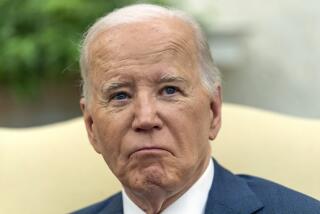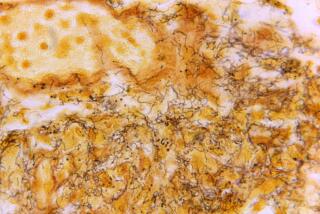Obama’s HIV/AIDS policy hailed for targeting spread of disease
Reporting from Washington — President Obama acknowledged an uncomfortable reality as he unveiled the nation’s first comprehensive national HIV/AIDS strategy at a White House ceremony Tuesday: Though the United States has made tremendous gains treating people infected with the virus, efforts to prevent the spread of the disease have continued to lag.
Even as the federal government has spent tens of billions of dollars to develop and administer drugs for HIV patients, the number of people newly infected every year has remained virtually unchanged for a decade. Today, an estimated 1.1 million people are infected with HIV, the virus that causes AIDS.
“We are keeping pace when we should be gaining ground,” Health and Human Services Secretary Kathleen Sebelius said at the White House.
The president’s plan, which includes targets for controlling the spread of the disease by 2015, calls for reducing new HIV infections annually by 25%, from an estimated 56,300 today.
It includes more than 100 directives to federal agencies including new standards for assessing prevention programs, new education campaigns for ethnic communities and increased screening of federal prisoners.
Dr. Georges C. Benjamin, executive director of the American Public Health Assn., called the strategy “a lifesaving public health intervention,” echoing widespread praise.
For many who have been laboring to control the disease, the specific steps are particularly welcome after years of disappointing progress. “We should have been doing better,” said David R. Holtgrave, an expert on HIV/AIDS policy at the Johns Hopkins Bloomberg School of Public Health.
American public health efforts, which in the late 1980s and early 1990s helped dramatically cut new infections from a peak of about 130,000 a year, have barely moved the annual number since.
There are now more new infections annually than there were in the early 1990s, when they bottomed out about 49,000 a year, according to estimates by the Centers for Disease Control and Prevention.
Today, an estimated 20% of people infected with HIV do not know it. The new strategy aims to cut that in half by 2015.
Particularly disturbing to many activists are the persistently high infection rates among gay and bisexual men, who account for more than half of all new infections, and among African Americans.
Black men and women account for 46% of people living with HIV, though they represent just 13% of the population, the CDC said.
U.S. officials and activists have made some progress reducing the likelihood that someone infected with the disease will transmit it. But many experts say the prevention efforts have not kept pace with the development of powerful drugs that allow many people with HIV to live relatively normal lives.
Part of the challenge is the success produced by medical breakthroughs, said Jennifer Kates, who directs the global health policy and HIV program at the nonprofit Kaiser Family Foundation.
“People are just not as concerned about HIV,” Kates said. “There is a sense we have treatments, that HIV doesn’t seem as bad as it used to…. There is more complacency.”
Julie M. Scofield, executive director of the National Alliance of State and Territorial AIDS Directors, said Americans also continued to struggle with issues involving sex, race and homosexuality, all crucial topics in HIV prevention.
“One of the things that the strategy does very well is discuss those issues very directly,” Scofield said, praising the Obama administration’s report for targeting specific populations.
But the strategy does not promise any more money.
And at a time when an estimated 4% of the federal government’s $19-billion domestic HIV/AIDS budget goes to prevention, some activists said that could remain a barrier to this new effort to slow the spread of the disease.
More to Read
Sign up for Essential California
The most important California stories and recommendations in your inbox every morning.
You may occasionally receive promotional content from the Los Angeles Times.











